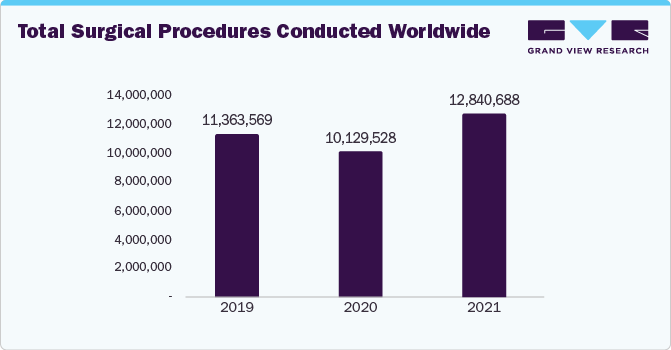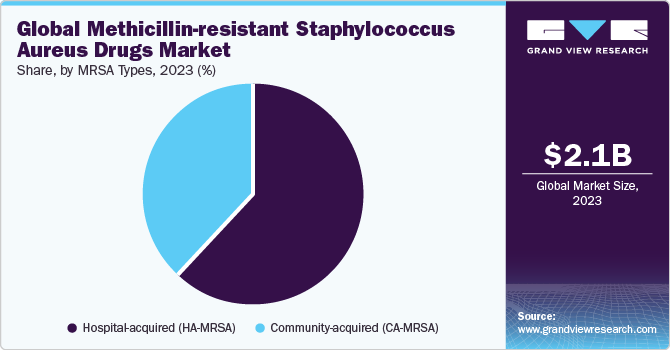- Home
- »
- Pharmaceuticals
- »
-
Methicillin-resistant Staphylococcus Aureus Drugs Market Report, 2030GVR Report cover
![Methicillin-resistant Staphylococcus Aureus Drugs Market Size, Share & Trends Report]()
Methicillin-resistant Staphylococcus Aureus Drugs Market Size, Share & Trends Analysis Report By Drug Class, By MRSA Types, By Disease Indication, By End Use, By Region, And Segment Forecasts, 2024 - 2030
- Report ID: GVR-4-68040-195-3
- Number of Report Pages: 110
- Format: PDF, Horizon Databook
- Historical Range: 2018 - 2021
- Forecast Period: 2023 - 2030
- Industry: Healthcare
Market Size & Trends
The global methicillin-resistant staphylococcus aureus drugs market was valued at USD 2.15 billion in 2023 and is expected to grow at a compound annual growth rate (CAGR) of 5.51% from 2024 to 2030. This can be attributed to the pipeline space, and major pharmaceutical firms are advancing the future development potential of the methicillin-resistant Staphylococcus aureus (MRSA) infection pipeline area.

The key factor responsible for the growth of the methicillin-resistant Staphylococcus aureus (MRSA) drugs market is a spike in the incidence of methicillin-resistant staphylococcus aureus infections worldwide. MRSA seems to increase mortality and morbidity in geriatric persons, nursing home patients, and those with organ failure, according to the study "Methicillin-Resistant Staphylococcus Aureus," released in April 2023. Hospital-associated methicillin-resistant Staphylococcus aureus has a high risk of spreading to patients with end-stage liver illness, renal failure, and those admitted to the intensive care unit (ICU). According to the data, death rates range from 5 to 60% depending on the patient category and infection location. In addition, researchers found that more than 60% of individuals get MRSA within 48 hours of hospitalization despite having no health risks.
The epidemiology of methicillin-resistant Staphylococcus aureus infection is principally characterized by the repeated development of epidemic strains despite the genetic diversity of the disease. In addition, despite the recent decrease in occurrence in some areas, MRSA continues to pose a serious clinical hazard due to its consistently high morbidity and fatality rates. The assessment of both new antibiotics and ancillary parts of care, such as infectious disease consultation, echocardiography, and source control, is necessary for successful therapy, which is still difficult to achieve. Thus, research and development of new methicillin-resistant Staphylococcus aureus drugs are anticipated to drive market growth.

Drug Class Insights
Based on the drug class, the methicillin-resistant staphylococcus aureus (MRSA) drugs market is segmented into sulfa drugs, tetracyclines, oxazolidinones, folate antagonists, lipopeptide, glycopeptide antibiotics, and others. The glycopeptide antibiotics segment held the largest market share in 2023. This can be attributed to the significant availability of glycopeptide antibiotics, including the anti-infective antibiotics ramoplanin and decaplanin, teicoplanin, vancomycin, telavancin, corbomycin, complestatin, and the antitumor antibiotic bleomycin. Thus, the wide availability of methicillin-resistant Staphylococcus aureus drugs for treating methicillin-resistant Staphylococcus aureus infection is anticipated to drive segment growth.
MRSA Types Insights
On the basis of MRSA types, the market is segmented into hospital-acquired (HA-MRSA) and community-acquired (CA-MRSA). The hospital-acquired (HA-MRSA) segment held the largest market share in 2023. This can be attributed to the growing number of hospital-acquired infections. Hospitals are hotbeds of bacteria and viruses, and MRSA infection is a common problem after surgery. About 10% of hospital-associated infections in the US are caused by MRSA, and these infections are linked to a higher risk of mortality. Thus, an increasing number of surgical procedures in hospitals is anticipated to drive segment growth.

Disease Indication Insights
Based on the disease indication, the methicillin-resistant staphylococcus aureus (MRSA) drugs market is segmented into skin infections, bone and joint infections and bacteremia, and animal infections. The skin infections segment held the largest market share in 2023. Skin infections frequently result from bacterial infections. Most commonly, the germs Streptococcus and Staphylococcus are to blame for illnesses including cellulitis, impetigo, and boils. Additionally, a number of initiatives and educational campaigns run by producers and promoters in several nations have raised awareness of the value of utilizing MRSA drugs for skin infection treatment to drive segment growth.
End Use Insights
Based on end use, the methicillin-resistant staphylococcus aureus (MRSA) drugs market is segmented into hospitals and clinics and research and academic institutes. The hospitals and clinics segment held the largest market share in 2023. This can be attributed to an increase in the number of surgical procedures requiring high-intensity infection prevention & control, an increase in the incidence of hospital-acquired infections, and an increase in the number of government awareness programs to ensure a high degree of infection prevention.
Regional Insights
North America dominated the market in 2023. This can be attributed to the strong presence of local companies engaged in the research and development of MRSA drugs for treating infection caused in healthcare settings due to MRSA. The key companies that offer their products in the North American region include Pfizer Inc., GSK plc., Proctor & Gamble, Novartis AG, and others. Thus, developing and commercializing new drugs in the U.S. and Canada is anticipated increase the regional market. Asia-Pacific is expected to witness the fastest CAGR over the forecast period.
Key Methicillin-resistant Staphylococcus Aureus Drugs Companies
The following are the leading companies in the methicillin-resistant staphylococcus aureus drugs market. These companies collectively hold the largest market share and dictate industry trends. Financials, strategy maps & products of these methicillin-resistant staphylococcus aureus drugs companies are analyzed to map the supply network.
Key players operating in the market are Procter & Gamble, Johnson & Johnson Services Inc., AbbVie Inc., Merck & Co., Inc., Baxter, Sun Pharmaceutical Industries Ltd, Teva Pharmaceutical Industries Ltd., Novartis AG, Pfizer Inc, and GSK plc. The market participants are working towards R&D of new products, collaboration, M&A activities, and other strategic alliances to gain new market share. In 2023, Basilea Pharmaceutica Ltd announced that it had submitted a new drug application (NDA) to the U.S. FDA for treating patients in three indications: Staphylococcus aureus bacteremia (SAB), including acute bacterial skin and skin structure infections (ABSSSI), community-acquired bacterial pneumonia (CABP), and right-sided infective endocarditis,
Share this report with your colleague or friend.
![gvr icn]()
NEED A CUSTOM REPORT?
We can customize every report - free of charge - including purchasing stand-alone sections or country-level reports, as well as offer affordable discounts for start-ups & universities. Contact us now
![Certified Icon]()
We are GDPR and CCPA compliant! Your transaction & personal information is safe and secure. For more details, please read our privacy policy.
We are committed towards customer satisfaction, and quality service.
"The quality of research they have done for us has been excellent."





